#digital trip
Explore tagged Tumblr posts
Text

Osamu Shoji – Round Vernian Vifam - Synthesizer Fantasy (1984)
219 notes
·
View notes
Text
Diving into the Digital Trip

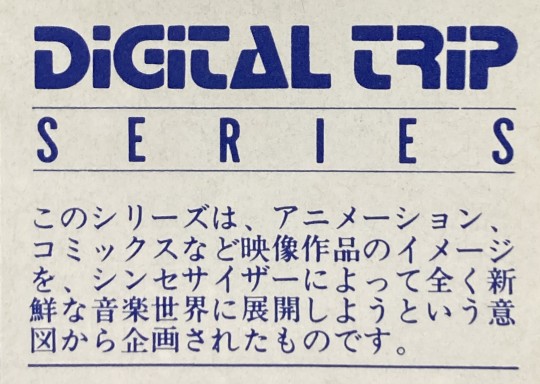
“This series was conceived with the intention of taking impressions from animation, comics, and other visual works and developing them into a completely fresh musical world using synthesizers.”
-Obi Strip Digital Trip Series Description, 1983 (SDF Macross DT, translated by Windii)
Intro
When I first started listening through tokusatsu soundtracks, I was going through the two-disc set for Uchuu Keiji Sharivan’s BGM and noticed that the second disc began with a set of songs titled “DIGITAL TRIP Uchuu Keiji Sharivan SYNTHESIZER FANTASY.” Upon playing those curious tracks, I was greeted with a very electronic, synthesized, and striking series of compositions. They were still recognizable as variations of the OST and BGM I’d heard earlier, yet they sounded almost otherworldly.
Years of anisong searching and listening later, and now as an avid music enthusiast, I’ve plunged into the huge range of the Digital Trip – Synthesizer Fantasy albums. Though only lasting around five years, the series saw many releases from a variety of arrangers offering their own, synthesizer-heavy takes on anime and other Japanese media music.
Some of the albums recently received worldwide streaming releases for the first time, but I wanted to write about this series anyways because of how much I enjoyed listening through and discovering so many favorites. I love synthesizer music of all kinds, especially ones that aim for their own distinctive style. The Digital Trip series is unique among both electronic and anime music, and I think it’s worth highlighting as a creative and entertaining series of albums.
This retrospective is a mix of contextual overview, notes on the styles of the main arrangers, a look at some of the tech used, the end of the line itself, and ten personal album recommendations.
(VGMDB is the source for most of the credits and dates in this post.)
Overview
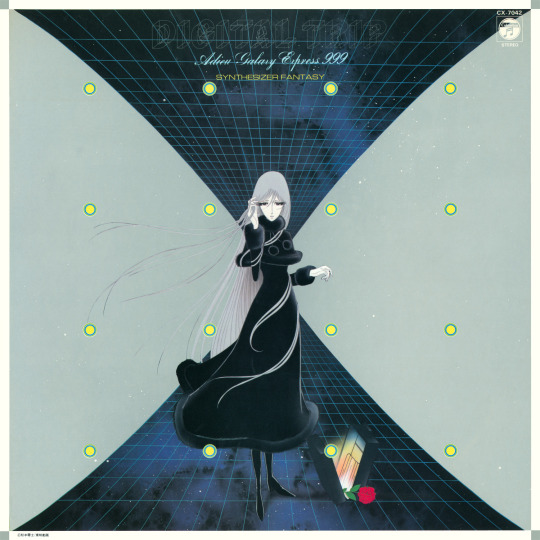
Digital Trip – Synthesizer Fantasy is a series of instrumental image albums released by the Nippon Columbia record label in Japan from December 1981 to May 1986. 51 albums (and one compilation) were produced for it, with each receiving a simultaneous vinyl and cassette release. At its peak, multiple albums were released almost every month, though the typical schedule had more gaps.
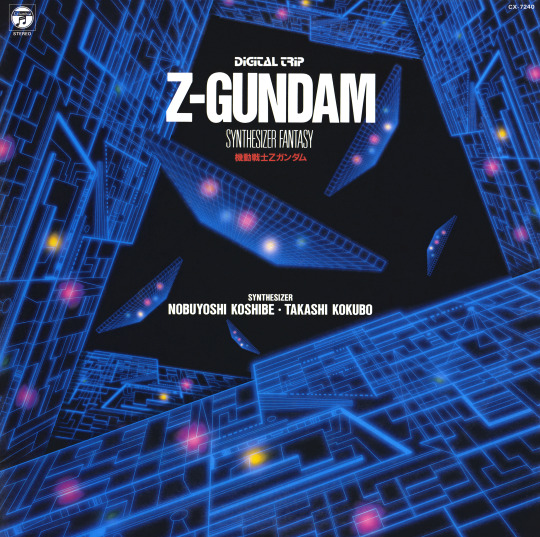
Befitting the name, the albums are synthesizer-focused re-arrangements of vocal, BGM, and image songs for select anime, manga, and even tokusatsu. A few albums have original compositions, but the majority are reinterpretations of existing songs and scores. The albums feature some of the newest emerging synthesizers, samplers, sequencers, and drum machines of their release years, though a rare few have more traditional instruments mixed in. Despite the “digital” name, older analog synthesizers are used on some albums alongside newer digital synths.
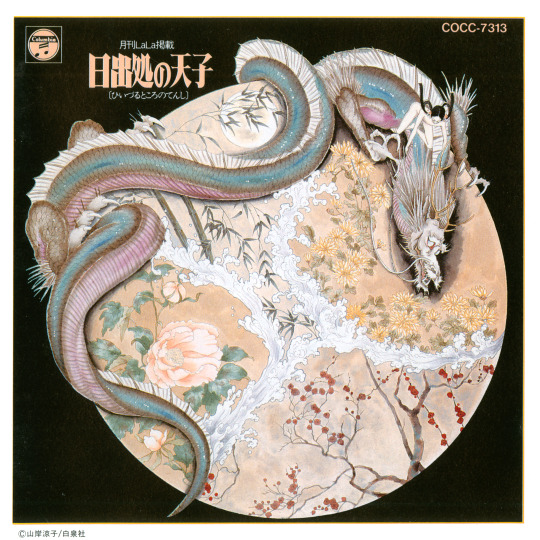
Nippon Columbia had other similar image album lines that started running concurrently in 1983. The Jam Trip series is the same concept as the DT albums but with jazz-fusion rearrangements instead of synthy ones, and the Roman Trip series is image songs for manga and books that had not received animated adaptations yet. Some of the early DT albums are original image albums for manga, but they soon switched to covering anime while the Roman Trip line focused on new image songs for non-animated works.
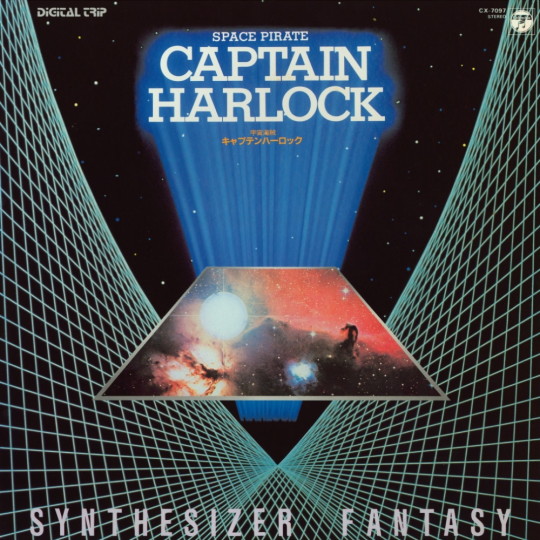
Image albums were common music releases throughout the late 70s and 80s onwards, but the DT series is focused on a more specific, overarching concept of making distinctly electronic renditions. The potential of synthesizers and newer computer technologies was captivating for musicians and audiences across the world at the time, so the DT series served as a chance to both experiment with these new tools and to showcase the kind of layered and unique compositions synthesizers were capable of.

This concept is also reflected in the album art, which tends to feature more abstract designs and lots of futuristic grid lines and shapes that aren’t always obvious reflections of their source anime. Most of the anime selected were science fiction and fantasy given the nature of the concept, but several non-fantasy anime also received albums.
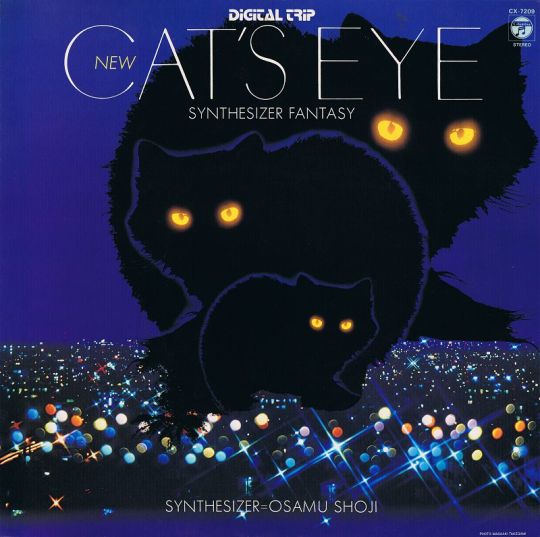
The tracks on DT albums are mostly based on the existing works of composers, but the actual arrangements and performance are handled by different arrangers, with a few exceptions. While the original compositions still influenced how each album ended up, the arrangers played the largest role in shaping them through their own skills and visions. The music in each album ranges from more conventional rearrangements, airy ballads, electro-dance, faster rock, atmospheric soundscapes, longer suites, and a whole host of other styles.
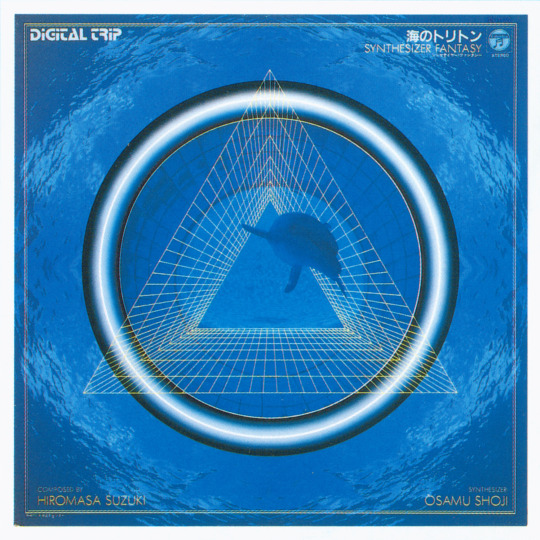
I don’t think any of the DT albums are bad, but the less unique ones fall into the trap of keeping the compositions too similar to the originals. The least interesting tracks sound just like the original songs with the instruments swapped, but those are thankfully rare. While the DT albums can be listened to without any knowledge of their base soundtracks, comparing them with their original scores highlights how creative and varied the rearrangements can be when working with a totally different sonic palette.
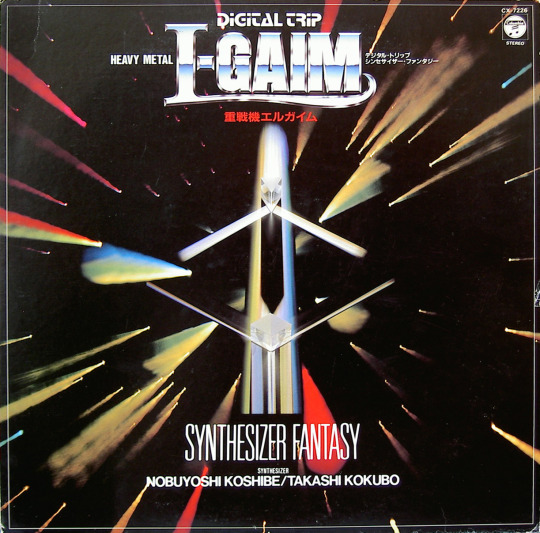
At their best, the DT albums strike a balance of being faithful enough that the original compositions are still recognizable while also transforming them such that they stand on their own. Sometimes multiple songs are mixed into larger suites, and other times each vocal song and chosen BGM gets its own track, but each track contains new flourishes and notes that add to the original compositions, as well as going into unpredictable directions and styles. The rearrangements of vocal songs are some of the livelier ones, but part of the enjoyment is seeing all kinds of songs reinterpreted though this “Synthesizer Fantasy” concept.
The Main Arrangers
While there were several one-off arrangers, the Digital Trip series had a rotation of regulars that carried their own styles across multiple albums. A few of the more prominent ones included:
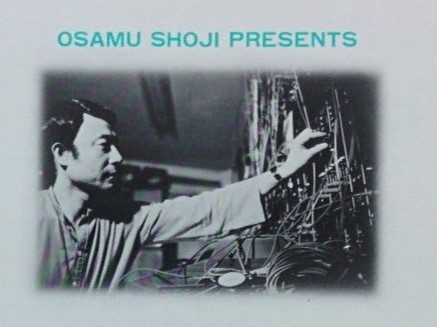
Osamu Shoji (“The Galaxy”): 20 albums
Osamu Shoji was the primary arranger of the DT series and handled a plurality of the albums. As the first and last arranger of the series, his progression throughout the run is interesting to track as he adopted many newer synthesizers and changed his sound the most.
Shoji’s arrangements are mostly straightforward, but that helps them maintain a solid base structure no matter how different the styles are from one track to the next. It reflects his adaptability that he was able to integrate so many different composers and genres into his DT albums that are distinct from both each other and their original soundtracks. Lots of his tracks tend to be more sequenced, but they use that to their advantage to create complex rhythms, tight grooves, and sturdy percussion backing the more active main melodies. His music’s audio mixes sound deep and well-rounded despite their many different sound tones. Shoji remained the most versatile and reliable arranger in the lineup, shaping the bulk of the DT series.
Shoji released many solo electronic albums and other assorted anime image albums, including the two “Synthesizer Fantasy” image albums that were not in DT series. He composed for a few anime including Adieu Galaxy Express 999, Cobra, and Wicked City.

Nobuyoshi Koshibe & Takashi Kokubo: 11 albums + 1 Koshibe solo
The second-most frequent arrangers, Nobuyoshi Koshibe and Takashi Kokubo used some of the wider varieties of synthesizers in the DT series. Their albums have a very crisp and buzzy sound, and their tracks often undergo several instrumental and style changeups throughout. They also feature some of the hardest rocking tracks in the DT series, especially with their louder use of sharper and heavy FM synth tones, but also with very processed, effects-heavy guitars for accents and solos. That said, their albums still have considerable range beyond their rock tracks, with many slower and more atmospheric songs that are gentler when needed.
Koshibe was already an extensive anime vocal song and soundtrack composer prior to the DT series for shows in the 60s and 70s, including giants like Saze-san and Mach GoGoGo/Speed Racer, and he continued working in anisong music afterwards. Kokubo only contributed to one other anime album outside of his DT work, and he was more focused on his solo electronic and new age albums.
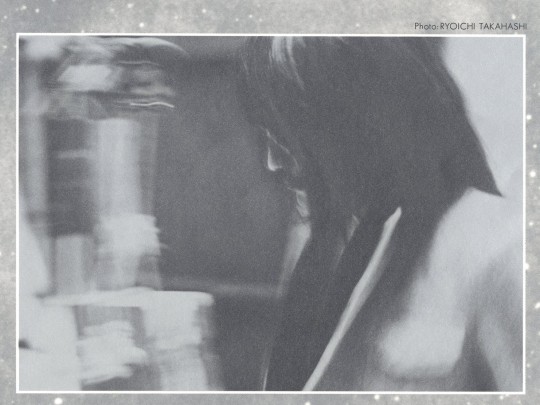
Jun Fukamachi: 4 albums
Though his albums were few, Jun Fukamachi had one of the most distinct and beautiful sound palettes in the entire DT series. Compared to the others, Fukimachi’s albums emphasize a much more “live,” almost classical performance with lots of gentle and expressive keyboard flourishes. His arrangements are mostly scarce on percussion and instead aimed for a more symphonic sound with layers of pads and arpeggios backing his sweeping synth leads and solos. While he has more upbeat and harsher songs, most of his works are ethereal and lush. Fittingly, three of his four albums are based on works by Leiji Matsumoto, and his arrangements excel at capturing the grand atmosphere of space opera.
Fukamachi made a couple of other image albums and never composed any anime scores, but he did have an extensive jazz-fusion and electronic career spanning dozens of albums.
Goro Ohmi: 4 albums
Goro Ohmi was more involved in the early run of the DT line. His first few albums have some accompaniment from live instruments while his later ones were more synth-centered. His works are some of the more accessible ones in that they tend towards more straightforward covers that stick closer to the original compositions. Still, they’re solid reinterpretations with enough creative additions. His synths are a touch more primitive than the others, but he still managed to make his arrangements sound full and varied.
Ohmi pivoted to handling many of the Roman Trip albums for Guin Saga, which he continued into the 90s. He composed a few anime and tokusatsu soundtracks afterwards, including Ginga Nagareboshi Gin, Grey: Digital Target, and Hikari Sentai Maskman.
Akira Ito: 2 albums
Akira Ito only composed two image albums of original music near the start of the series before he left the rotation early on. His works are some of the less “digital” in that they contain lots of traditional rock instrumentation, with the synths usually playing only the leads. His style is most akin to 70s progressive rock, with lengthier songs that all flow into each other to form large suites. His two albums have a very fantastical, journeying sound that’s not too representative of the DT line overall but remain interesting outliers.
Ito has a few anime image albums credited to him, but he was more focused on his solo electronic albums that continued this same style.
Appo Sound Project: 2 albums
Appo were a production group of composers and arrangers that arrived near the end of the series, but they still carved out a distinctive treble-focused, more high-NRG sound relative to the others. Their arrangements use sharper digital synthesizers that are very bright in their sound mixes, if occasionally on the thinner side. A lot of their arrangements were more up-tempo and not as subtle, but they have a constant energy that’s still enjoyable, especially in their tracks with multi-suite melodies.
Also of note is that the group features Kohei Tanaka in one of his earlier arranging roles. In fact, a lot of the synth sounds of their work are used in the electronic tracks he composed for his Choushinsei Flashman soundtrack soon after. Tanaka remains one of the most well-known anime composers of all time and went on to compose many, many soundtracks afterwards, though none really sound like his DT work.
Tech

(From the Adieu Galaxy Express 999 DT Album)
Given their concept, the Digital Trip albums are tied to the synthesizer technology of the early 80s, with all their quirks and limitations. The albums are rather accessible for early electronic music, but their sounds are challenging for those not as predisposed to synthesizers. Nevertheless, exploring aspects of the synth technology at the time illustrates the ingenuity needed to make the albums.
Early synthesizers and sequencers were trickier to operate and program compared to later advancements. All settings for sounds had to be individually connected with cables, tuned with knobs, or programmed with basic keypads. On the few units that had them, display screens were minuscule and had few lines. Storage banks were also limited, so saving any sounds to reuse for later often required meticulous notetaking.
Keys on older synthesizers were also not as touch-sensitive, meaning the notes would sound the same regardless of how fast or hard the keys were pressed. Pitch and modulation control were often present but rather basic. Polyphony, or the ability to play more than one key at once, varied widely by keyboards, which also made full chords harder to play.
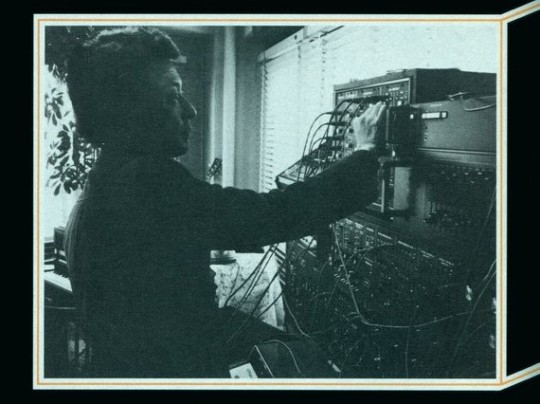
(Osamu Shoji, from the Adieu Galaxy Express 999 DT Album)
Many of the albums were made before the MIDI standard was codified in 1983. Pre-MIDI sequencers had limited interfaces that required all aspects of each note to be programmed individually, though this did allow for finer precision. Timing sequences with live playing was also a challenge for units that had variable sound consistency and different communication formats.
This made configuring each part of a single song with only synthesizers a laborious process, especially for albums that were 30 to 40 minutes long. The arrangers not only had to rearrange the original notes to work within the technical capabilities of each synthesizer they wanted to use, but they then had to make sure each synth was attuned and set up correctly for recording and mixing. Some DT albums have additional engineers credited who assisted with the tedious work of configuring these different systems and note sequences, but the arrangers were still responsible for the bulk of the work in planning and connecting all of these machines.
The liner notes for some albums include lists of the synthesizers and instruments used, which also reflect the habits of their respective arrangers. While going over the instruments for every album would be lengthy, comparing two albums that were both released in 1983 yet contained wildly different sounds illustrates these varying sonic approaches.

(Osamu Shoji using the Fairlight CMI, from the God Mars DT)
The Macross DT album by Osamu Shoji only lists the Fairlight CMI sampler, the Linn Drum II (the “classic” LinnDrum), and the Roland MC-4 sequencer. This means every non LinnDrum sound on the album is produced just from the CMI’s digital sample library, albeit with his own modifications and even his own sampled noises.
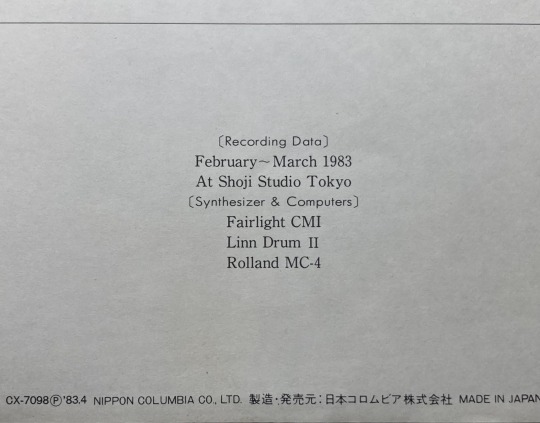
The album’s diverse styles and instruments, from the upbeat pop and action to the grander slow songs, reflect both the CMI’s depth and Shoji’s skill as an arranger and programmer. Shoji’s equipment range is broader on works like his Adieu Galaxy Express 999 and Gundam DTs, but the Macross DT demonstrates how it was still possible to make a wide-ranging album with such a small selection of tools that had expansive capabilities in the right hands.
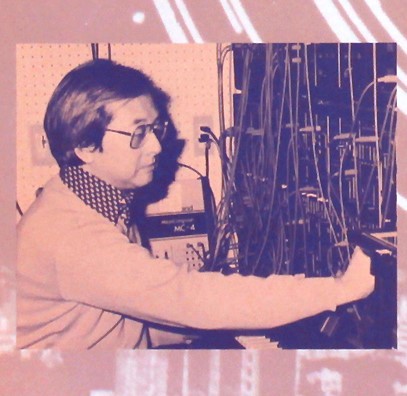
(Koshibe using the Roland System 700 and MC-4)
By contrast, the Urashiman DT by Koshibe & Kokubo has a longer and more peculiar list of instruments, and it also includes the recording and mixing equipment. The first synth listed is the analog Roland System 700 from 1976, an older modular synthesizer that required connecting streams of wires between each individual sub-unit and lots of manual tuning to get the desired sounds. A picture in the liner notes shows Koshibe working with both the System 700 and the MC-4 sequencer. The rest of the list contains a mix of synthesizers, both analog (Roland JP-4, SVC-350 vocoder) and digital (Yamaha CE-25, DX-7, Korg PS-3200), with vastly different sound tones, many of which show up across the duo’s other albums. The amount of moving parts to sequence, tune, and play is daunting, but the album’s layered sound reflects this approach well.
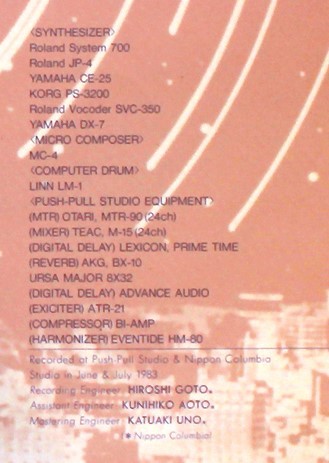
Not all the albums list the synthesizers used. Most of Fukumachi’s albums only have a generic “synthesizers” credit, which is frustrating considering how distinct his style is. Some albums have liner notes describing the process and approach taken for every track. The Macross DT liner notes go into the techniques Shoji used with the CMI and sequencers to make the album. I hope to get more of those translated in the future, but the depth of the arranging process is still reflected by the structure of the tracks.
While the technical craft in employing all of these tools is remarkable, there are limitations. Some albums unapologetically use presets that became cliched as the decade went on; the DX7’s tubular bells, the Fairlight CMI’s panflute samples, and the LinnDrum’s tom-toms show up quite a few times. The depth of the sounds and tones varies across the albums and arrangers, and many presets were at lower bit resolutions and sample rates than what future samplers were capable of. However, the use of digital instruments and sometimes recording does give most of the albums a better mix clarity than many of their associated soundtracks.
Knowing about the technical aspects is not needed to enjoy the albums on their own, but it does give deeper insight into how certain sounds and stylistic choices were possible. While it is easy to lump all early synth music of this kind as being generically “80’s,” the actual process was much more varied and evolving. The changing styles in the DT line reflect the technological advancement and programming refinement spreading throughout music at the time, which the arrangers furthered through their continuous work.
Other Uses
While some Digital Trip albums came out long after their respective anime and movies, most were released a short time after the first batches of official soundtracks. This meant they tend to cover music from the earlier episodes of 40-50 episode shows, though a few got sequel albums that covered later music.
Because the DT albums are image albums, their music was not intended for use within their respective anime, especially for shows with more traditional and orchestral soundtracks. I haven’t seen all the anime, shows, and movies with the associated albums, but I have seen enough to know it is exceedingly rare for any DT tracks to appear.

However, there are a few exceptions. Urashiman uses a few tracks from its DT album in some episodes across its endgame arc. The most memorable scene is in episode 45 where a stylish non-binary assassin demonstrates their skills to the villains, set to the DT version of the villains’ vocal insert song. It’s a great choice that makes the scene even punchier. Episodes 46-49 also use other more sweeping tracks from the album to accentuate more dramatic scenes.
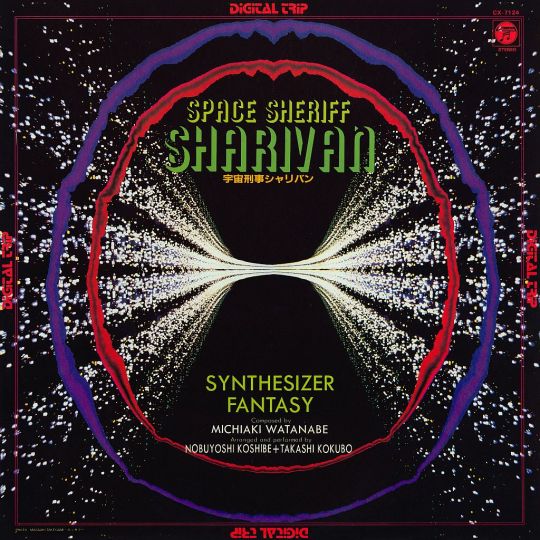
Sharivan also starts using DT tracks in episode 35, which uses a lengthy portion of the final song on the album for a heartfelt montage. More of the DT songs are used as insert songs in episodes throughout the rest of the series, making it likely the most extensively used DT album for its respective show. Sharivan does have lots of one-off synthy songs that aren’t the DT songs or on its official soundtrack, but the DT ones are still discernable with a keen ear.
In both cases, the respective shows’ soundtracks already had numerous synthesizer songs, so the DT albums fit more naturally in with the rest of the music. Coincidentally, both shows had their original soundtracks released by Nippon Columbia, but that’s a sample too small to make definitive claims about. Though rare, hearing DT tracks used in the shows is always a nice touch.
(If I ever find other examples of DT tracks used as insert songs, or other people are aware of some, I’ll update this section.)
The End of the Series and the Changing Landscape
The last album released in the Digital Trip series was the Arion album in May 1986. I can’t find a source on why the series ended, and it’s not helpful to throw out baseless speculations on why. That said, the changing landscape around the DT albums is still interesting and reflective of the series’ legacy.
As the 80s rolled along, synths became more conventional parts of anime scores rather than getting used primarily as accents, a change facilitated as the technology advanced and got easier to use. Some of the original novelty of hearing electronic-centered albums was dissipating as some anime scores themselves became very electronic. Nevertheless, the DT series was still dedicated to making unique arrangements on their own that differed from the synth work in their respective anime.
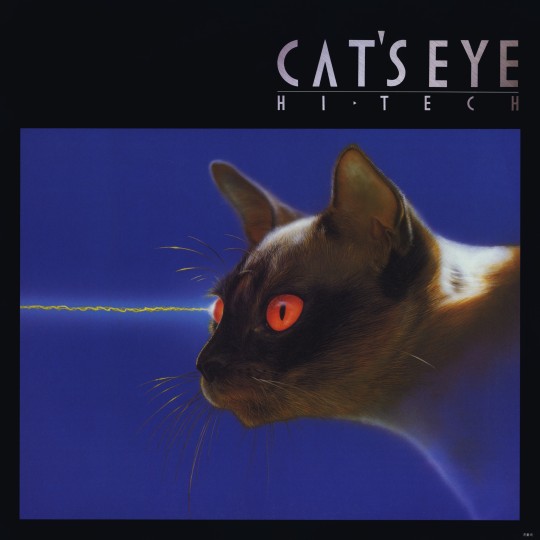
However, other sublines of electronic rearrangement albums began emerging at the same time. The Animage label launched their own line of synth-focused image albums called the HI▾TECH series in 1984, although those albums often included more regular instruments than most of the DT entries. Because both the DT and HT lines were covers and rearrangements, some anime received albums in both lines. The HT series ended its regular releases in 1986, but it released a few other albums over the following years.
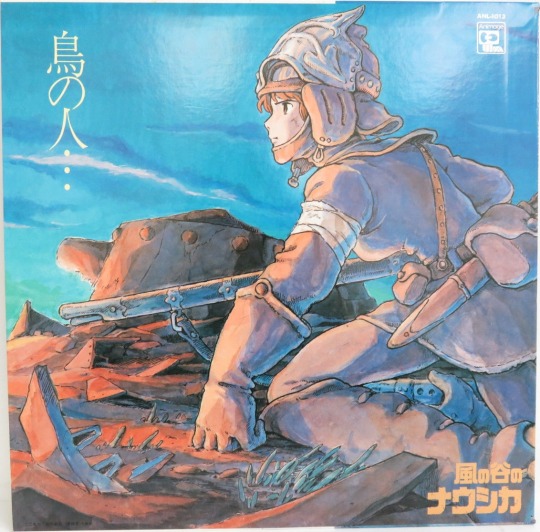
Additionally, other electronic-centered image albums were increasingly helmed by the composers of their anime’s soundtracks. As Joe Hisashi’s career began taking off, he started creating synth-focused image albums that were often released before their respective movie scores, in some cases functioning as “prototype” scores as he was still working on the main soundtrack, including ones for Nausicaa and Arion. He continued the practice through the end of the decade with albums like his Venus Wars image album.
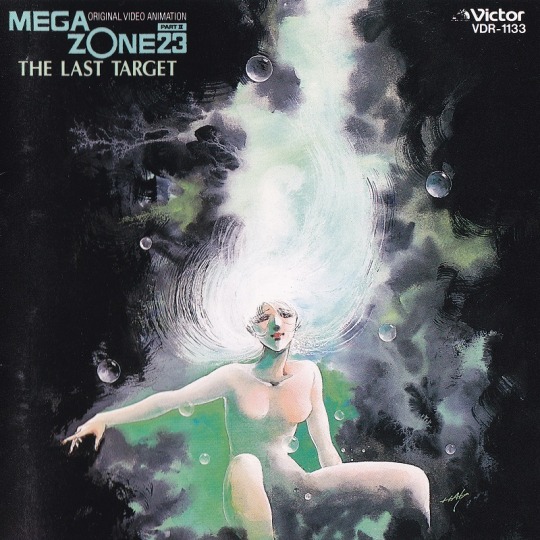
Shiro Sagisu, another then-upcoming composer, took a similar route with his music for Megazone 23 under his TOKIO 23 unit. Megazone 23’s score was already very electronic, but he released two additional synth-heavy image albums in between the releases of the scores for Part I and II that were not only rearrangements, but also contained unique compositions. More composers were feeling confident and adept with synthesizer and electronic music to begin releasing their own image albums in addition to covers from outside arrangers.
The case of the Arion soundtracks illustrates this expanding field. Through the span of year from 1985-6, Arion had its partially synthy movie soundtrack, a Digital Trip album, a Hi-Tech album, and a separate synth “prototype” image album by Hisashi himself, not to mention an even earlier 1983 synthy image album based on the manga that predates the movie score. That’s a huge saturation of Arion synth albums, reflecting how more releases were competing for the same niche the DT series had occupied.
Now, I’ve had enough experience with nonsense internet anime rumors to say that none of this is verifiably connected to the reasons the DT series ended, and it should not be treated as such.
Nevertheless, these circumstances highlight how aspects of the DT series became featured in contemporaneous soundtrack and image albums, which to an extent succeeded the DT line after it ended. More producers, artists, and most importantly, consumers were now acquainted with and enthusiastic about synthesizer music than ever before. Synthesizers were now a core, if not predominant aspect of many anime and popular music albums compared to their marginal use earlier in the decade when the DT series began.
The Digital Trip Albums Now
After the initial run in the 80s, 14 of the albums were remastered onto CD in 1993 under Columbia’s Digital Trip 1800 series. The original LP art was shrunk within a wider blue border, but the booklets mostly contained the same liner notes. 10 of those CDs were reprinted again on CD-R’s under the R-Ban series in 2001.

A few were also remastered onto CD on other compilation releases: the Sharivan DT on the two-disc Sharivan OST and other compilations, both the Yamato and Final Yamato DTs on the Yamato Sound Almanac series, and the Harlock DT in the Harlock Eternal File series, to name a few.
In 2012, Columbia put out a digital-only compilation release that included a few tracks from DT albums that had no CD remasters. Curiously, the release has no tracks from Osamu Shoji and has a large chunk of its tracklist taken up by songs from the Ultraman DT album, except for its final one.
Unfortunately, the majority of the DT albums remain exclusively on their original vinyl and cassette releases and have not seen any official CD or digital transfers, and it is uncertain if they ever will unless Nippon Columbia decides to do so. The 2012 compilation is evidence that Columbia still has the materials available to make remasters for at least a few more albums, but there’s been no sign they’re considering any more.
Somewhat recently, the DT albums in the R-Ban series and two other CD-released ones were officially uploaded to streaming on Spotify, Apple Music, and Youtube Music. (6/5/24: The Sharivan DT was also released as a part of the uploads for the Metal Heroes Super Hero Chronicles, at the end of the fourth album). Curiously, the artwork on these releases is edited to remove all mentions of the phrase “Digital Trip”, both on the title borders and the original album cover. This does result in a few comically empty spaces, like on the Arion cover, but it’s an odd choice since they’re still titled “Digital Trip” in the album names.

As usual for anime fans, the best option to find most of these are through the varying places online. A fair number of them get uploaded to Youtube for the more casual listeners, but the majority are not too hard to find through other sources including conventions, digital stores, and fan rips floating around online.
Conclusion

There’s more to the Digital Trip – Synthesizer Fantasy line and its many albums, but this is about everything I wanted to touch on for now. The albums remain decently well known among retro anime music enthusiasts, but that’s about three layers of niches, so I think I can say that they are still relatively obscure to wider anime fans. The electronic nature of the series is its defining attribute, and that may take some time to get invested in. Still, this is a topic I wanted to cover mainly as a passionate fan but also to provide a decently comprehensive overview of a noteworthy anime image album series.
Synth-focused image albums appeared before and continued well after the Digital Trip series, but it stands as a noteworthy confluence of trends whose arrangers produced many unique, varied, and most of all, engaging albums. A DT album is appreciable irrespective of the original soundtrack it is arranging. Some of my favorite DT albums are for anime I haven’t seen or whose scores I haven’t heard because they were still that evocative on their own. Still, comparing the two highlight interesting aspects of the rearrangements needed to bring the music to synthesized soundscapes.
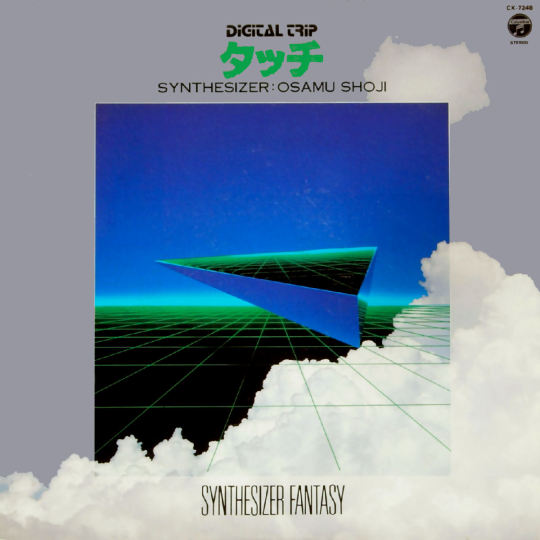
In the future, I hope to have more of the liner notes from the albums translated to shed even better details on the arranging process. Some of this overview involved generalizing, but I always want to get down to more precise details whenever possible. I may return to covering other aspects of the albums in the future, and I also plan to check out more of the non-DT works from all the respective arrangers.
After this section, I have ten personally recommended Digital Trip albums, in no particular order, as well as additional notes for a few external links, including a playlist of all the officially streaming ones on Youtube.
I encourage anyone interested in anime music, earlier electronic music, or those curious in general to check these albums out. The Digital Trip series is one of my favorite anime image album lines, and I think they carved out a distinct identity that remains interesting even so many years later.
10 Personal Favorites
SDF Macross (Osamu Shoji) – A solid selection of the show’s most famous vocal songs and BGM tracks (although curiously lacking “Watashi no Pilot”) that mixes idol-pop catchiness, fast-paced action, and grander spacey tracks. The bending and expressive keyboard basslines are a huge highlight. The Macross II: Minmay’s Songs album by Koshibe & Kokubo is also an interesting contrast in tech and style. (Translated liner notes for the album are here.)
Uchuu Keiji Sharivan (Koshibe & Kokubo) – My favorite of the Koshibe & Kokubo albums and the first I listened to, this one has lots of very sharp and buzzy FM synth tones. The rare splashes of electric guitars have tons of processing that make them sound roaring. Since Sharivan had a larger album of vocal songs to draw from than most of the other shows, the arrangements here are very lively and go through some fun changeups.
Umi no Triton (Osamu Shoji) – Though much later to its anime compared to the others, this album shines the most in its very catchy beats and rhythmic pulses. While not as atmospheric and sweeping, it still captures an oceanic feel with its twinkling arpeggios and chunky bass. It’s an unexpected combination of styles that works surprisingly well.
Gekkan La La Rensai Hiizuru Tokoro no Tenshi (Akira Ito) – This one is technically closer to the Roman Trip albums since it contains original compositions based off a historical fantasy manga and uses more traditional instruments in several parts. Still, it has a wide range of tracks that all connect into a continuous suite, making it one of the more cohesive and adventurous albums of the DT series, with lots of Japanese-styled instrumentation.
Mechadoc (Koshibe and Kokubo) – An underrated album that reflects the automotive feeling of its anime. Its highest energy tracks capture the grittiness and speed of racing and rally cars, especially some of the sharp FM lead solos, while the more mellow tracks round them out with gentle tones. The songs are lengthy but shift and develop in engaging ways.
Lensman (Osamu Shoji) – As well as having a more futuristic vibe overall, this album really excels with its rapid, complex drum and percussion patterns. Most of the album is a solid combination of upbeat action and funkier tracks, but towards the end there’s slower atmospheric cuts that balance things out.
Cat’s Eye (Osamu Shoji) – A more city-pop effort that’s very playful and even cutesy at times, most so with its danceable beats and bouncy basslines. The longer track list also allows for more songs that are focused and succinct. Shoji’s New Cat’s Eye album for the show’s second-season music continues a similar style.
Nausicaa (Junko Miyagi) – From the one-off (and only female) arranger Junko Miyagi, this one is among the most fantastical and soaring of the DT albums, especially with its thick bass pads and whistling tones. It’s also different from the many image albums Joe Hisashi made for Nausicaa, so it’s a good entry point for those already familiar with his music and curious about the DT albums’ overall concept.
Queen Emeraldas/Emeraldus (Jun Fukamachi) – My favorite of Fukamachi’s works, it features some of the lushest arrangements of the entire DT series, including several original compositions. The many glistening arpeggios and gentle keyboards perfectly evoke the feeling of travelling the immense galaxy with tracks that sound both forlorn and blissful. It also comes the closest to feeling like a “live” performance with its subtle, expressive keys.
Arion (Osamu Shoji) – The last DT album released, Shoji showcases his widest range in a lengthy tracklist covering almost every major cue from the movie score. The rapid and rhythmic drums accentuate many tracks nicely, the synth tones have greater depth and layers, and the varied arrangements capture the score’s fantasy atmosphere. It’s a well-rounded and solid album that’s also a fitting sendoff for the series.
Other Links and Miscellany
A playlist of all the officially streaming Digital Trip albums on Youtube, organized chronologically by release date. Lots of the others are available through fan uploads.
VGMDB is an invaluable database for these albums, even if many entries still need more complete details and could always use more contributors and enthusiasts. Note that viewing the full album art and insert scans requires an account.
The aforementioned 2012 Columbia digital release, which has some previews of some other DT tracks.
For a better introduction to synthesizer tech, I can recommend this two-part article from Yamaha on the history of synthesizers and an article from MIDI on the history of sequencing.
This video demonstration of the Roland MC-4 sequencer by Alex Ball is an excellent showcase of its programing process, as well as how arduous it was to make a full sequence. His channel in general is great if you’re into older synthesizers!
For a while only the R-Ban ones were on streaming, but two other CD ones were added to streaming as I was writing this post. Here’s hoping for more!
One oddity MartyMcFlies helpfully pointed out to me; there is a synthesizer album for the Odin: Photon Sailer Starlight film that’s titled “TPO Synthesizer” that has both original music used in the film and synth image covers of the film’s other BGM. “Digital Trip” is printed on the LP label itself, but without the “Synthesizer Fantasy” tagline (instead it’s “Digital Trip Original Soundtrack”). The DT tagline is not mentioned anywhere else in the album, and it does not seem to be included in any listings of the line. He has no idea what the situation behind this weird printing is, but he asked me to mention it regardless. Thanks Marty!
6/5/24:
As a part of the Super Hero Chronicles Albums for the Metal Heroes shows, the Sharivan Digital Trip is also now on streaming at the tail end of the fourth album.
2 notes
·
View notes
Text

You got a fast car
Is it fast enough so we can fly away?
We gotta make a decision
Leave tonight or live and die this way
#wild life smp#wild life fanart#traffic smp#traffictblr#life series#life series fanart#mcyt fanart#life series winners#digital art#my art#artist on tumblr#grian fanart#inthelittewood fanart#joel smallishbeans fanart#goodtimewithscar fanart#scott smajor fanart#pearlescentmoon fanart#zombiecleo fanart#wlsmp fanart#love them all having a road trip#joel’s car winning with him is hilarious
5K notes
·
View notes
Text

*in the fading light*
[ID: A digital illustration of a gay trans couple sharing an intimate moment , drawn in two panels. The top panel features the couple cropped close, just showing them kissing, with a transparent starburst around their mouths. The second larger panel is cropped from the shoulders to the thigh. One figure is in the center, sprawled back as their partner touches their stomach and kisses their shoulder. They are both shirtless with top surgery scars, and the center figure has boxers on. There is a third narrow panel on the left side, showing a simple skyscape of a orange star falling through clouds. The whole illustration is done in a restricted palette of soft warm green and teal, with pops of orange. /. End ID]
#hands you some t4t kisses#hands you even more t4t kisses#i trip and hundreds of drawings of gay trans dudes making out fall out of my pockets#also i hope this ID is okaaayyyy describing multiple panels and people is trickier than my normal drawings#if there’s any awkward parts or things that could be described better please let me know!!!#my art#illustration#queer art#mossymountain#trans art#transgender#digital art#trans masc#ftm#t4t#gay artist#orcaking
4K notes
·
View notes
Text


some WIPs that’ve been untouched since last year haha OOPS
#I forgor 💔💔💔#ALSO HI IM BACK FROM MY WEEKEND TRIP THAT NOONE KNEW I WAS ON YAY#artists on tumblr#digital art#the magnus archives#the magnus archive fanart#tma#tma fanart#magnus archives#micheal distortion#helen distortion#michael shelley#helen richardson#animation#animated gif
5K notes
·
View notes
Text

sdr2 turns 12 years old today! Thanks for dramatically changing the course my life three years ago stupid game im trans now
#art#danganronpa#sdr2#sdr2 fanart#danganronpa fanart#danganronpa 2#hajime hinata#nagito komaeda#komahina#digital art#not super happy with this anymore but Whatever Folds hands and walks away and trips#the coconut tree was inadvertent but well timed!#artists on tumblr#dr2
4K notes
·
View notes
Text

Art block so bad I drew my fave falling down stairs.
#he’s okay. he just tripped.#bnha hawks#mha hawks#takami keigo#my hero academia hawks#mha fanart#bnha fanart#boku no hero acedamia#my hero acedamia#bnha#mha#wing hero hawks#digital drawing#fanart#artists on tumblr#mha memes#dartbread
5K notes
·
View notes
Text

Part 2 to this
#the girls are next#they wanted a girls road trip#damian wayne#damian al ghul#robin#duke thomas#the signal#bruce wayne#batman#batfam#batfam fanart#fanart#art#my art#digital art#doodle#dc#dc comics
4K notes
·
View notes
Text


How fun (。ノω\。) 🇯🇵🇯🇵🇯🇵🇯🇵🇯🇵
#ijustwannahavefunn's art#creepypasta#fan art#digital art#jeff the killer#ben drowned#sally creepypasta#masky#eyeless jack#janethekiller#Tsutenkaku tower#japan#japan trip
7K notes
·
View notes
Text


Fishing trip ^^
#my art#artwork#digital art#art#artists on tumblr#digital arwork#dungeon meshi#delicious in dungeon#chilchuck#senshi#chilshi#pots and picks#something something gay sex joke#one hell of a fishing trip
1K notes
·
View notes
Text
the archives when its magnusing,, idk im at season 3 finale and im very upset abt it
#tma#artists on tumblr#fanart#digital art#animatic#tmagp#tma fanart#tma podcast#jonathan sims#the admiral#EP 119 WAS AN ACID TRIP FOR ME CUZ IDK I WAS STRAIGHT UP#CONFUSED FOR 16 MINS JENCKENCKN
2K notes
·
View notes
Text

I think this is the most humans I’ve ever drawn in a single sitting . Exhausting. Anyway even after all these years Koujaku still clears it’s not even a competition I love you koujaku
#art#my art#digital art#drawing#fanart#illustration#clip studio paint#anime#visual novel#nitro+chiral#dmmd#dramatical murder#aoba seragaki#koujaku#koujaku dmmd#noiz#noiz dmmd#mink dmmd#virus dmmd#trip dmmd#clear dmmd#ren dmmd
1K notes
·
View notes
Text

Been playing a lot of IS on my free and not free time so I got a bit inspired to draw Skadi alter...I wish I had her
Tried to pararell it with my drawing of Specter Alter!!
#arknights#skadi#skadi the corrupting heart#skadi arknights#my art#artists on tumblr#digital painting#Yippie yippie#I'm in a short trip rn so I'm trying to finish some stuff in my tablet
1K notes
·
View notes
Text
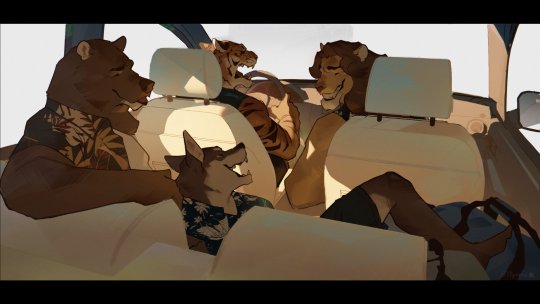
Trip down memory lane 🚗✨️✨️
#artists on tumblr#artwork#digital art#furry#my art#sfw furry#wholesome#comic art#furry art#road trip#cars#furry friends#illustration#illustrative art
2K notes
·
View notes
Text



In my heart it’s still Halloween and that’s all that matters
#trigun#trigun maximum#trigun manga#livio the double fang#meryl stryfe#razlo the tri punisher of death#razlo the trip of death#milly thompson#nicholas d wolfwood#vash the stampede#drawing#sketch#digital art#fan art
796 notes
·
View notes
Note
Can you imagine if Wretched Jax and Carnival Jax could get along and become great friends? Or would the two of them fight until one died?
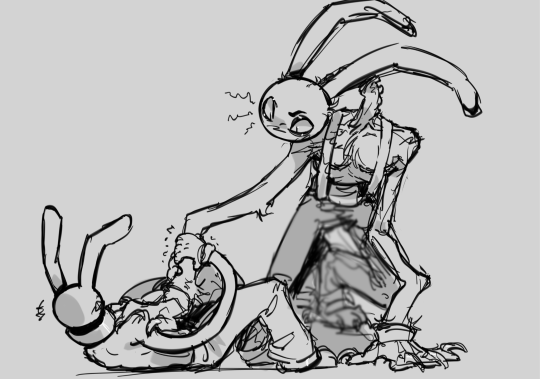

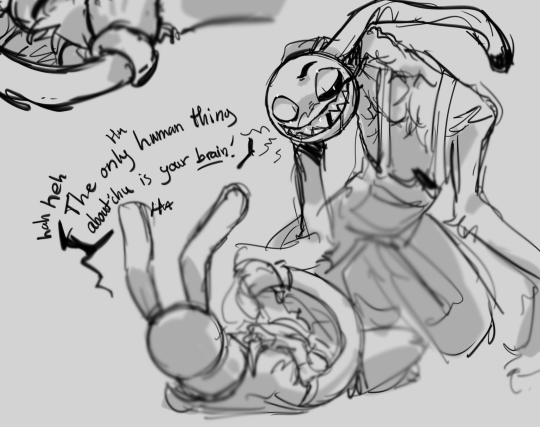
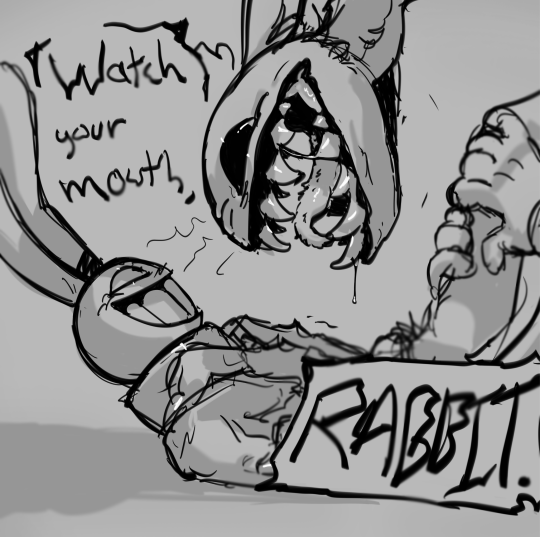
No, they wouldn't get along. Also, unless ive missed some lore, im pretty sure the carnival AIs cant exactly die so... wretched's got an annoying rat to deal with now /lhj
Less srs and more silly doodles below
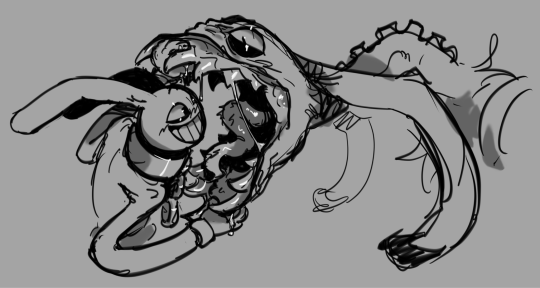

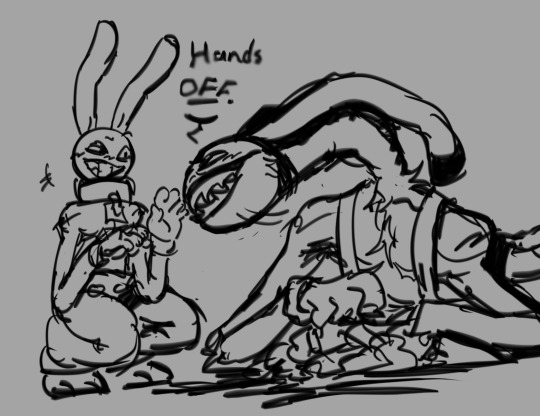
#havent slept and i think i miight be. a lil delerious rn#been on a road trip and have been drawing to pass the time#so yeah#uhh. the guys ever?#too tired to say much more but i like the silly dynamic between these 2#tadc#carnival jax#the amazing digital circus#the amazing digital carnival#sm baby#my art#wretched!jax#the wretched digital circus au#jax#tadc jax#tadc horror au#fyp#jax the amazing digital circus#jax tadc#tadc art#for you#fanart#au fanart#tadc au
1K notes
·
View notes